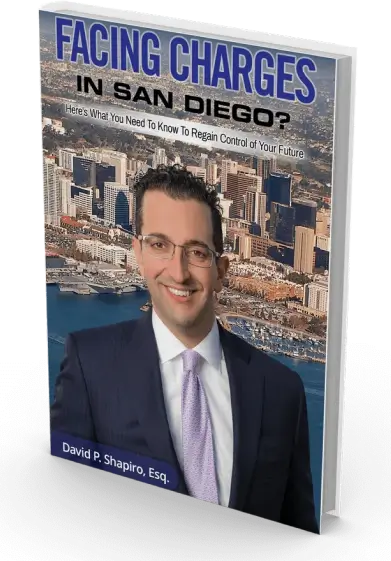Arrested or Charged with Aggravated Assault (Penal Code § 245) in California?

Aggravated assault charges in California carry serious consequences, including significant prison time, hefty fines, and long-lasting impacts on your personal and professional life. While simple assault is treated as a misdemeanor under California law, aggravated assault—legally known as “assault with a deadly weapon” or “assault likely to produce great bodily injury” under Penal Code § 245—is a much more serious offense.
At David P. Shapiro Criminal Defense Attorneys, we have substantial experience defending clients against aggravated assault charges in San Diego County. This article explains what constitutes aggravated assault, the potential penalties, and defense strategies available if you’re facing such charges.
What is Aggravated Assault Under California Law?
California Penal Code § 245 defines several types of aggravated assault. The common thread among these charges is that they involve assault committed in a way that significantly increases the potential for serious harm to the victim. Unlike simple assault, which requires only an attempt to use force against another person, aggravated assault involves either:
- Using a deadly weapon or instrument
- Using a firearm (with enhanced penalties for specific types of firearms)
- Using force likely to produce great bodily injury
- Assaulting certain protected individuals like peace officers or firefighters
It’s important to understand that actual injury to the victim is not required for an aggravated assault conviction. The prosecution only needs to prove that you acted in a way that could have resulted in serious injury.
Types of Aggravated Assault Under PC § 245
Penal Code § 245 outlines several distinct categories of aggravated assault, each with different elements and penalties:
Assault with a Deadly Weapon (PC § 245(a)(1))
This involves assaulting someone with any object that could cause death or serious injury. California courts have found many objects to qualify as “deadly weapons,” including:
- Knives, swords, or other sharp objects
- Clubs, bats, or blunt instruments
- Vehicles (when used in a manner likely to cause injury)
- Household objects like scissors, screwdrivers, or chairs
- Dogs trained to attack
- Even seemingly harmless objects used in dangerous ways
The key factor is whether the object was used in a manner capable of producing death or serious injury.
Assault with a Firearm (PC § 245(a)(2))
This specific category applies when the assault involves any type of firearm. California law treats firearm assaults more severely than assaults with other deadly weapons, reflecting the increased danger firearms pose.
Assault with Specific Dangerous Firearms (PC § 245(a)(3))
This enhanced charge applies to assaults involving:
- Machine guns
- Assault weapons (as defined by PC § 30510 or § 30515)
- .50 BMG rifles
These weapons are considered particularly dangerous, resulting in significantly longer potential prison sentences.
Assault with Force Likely to Produce Great Bodily Injury (PC § 245(a)(4))
This category doesn’t require a weapon at all. Instead, it focuses on the amount of force used and whether that force was likely to cause significant injury. Examples include:
- Punching someone with extreme force
- Pushing someone down a flight of stairs
- Choking or strangling someone
- Gang attacks involving multiple assailants
Assault with a Semiautomatic Firearm (PC § 245(b))
California law specifically enhances penalties for assaults involving semiautomatic firearms, which can fire multiple rounds quickly without manual reloading.
Assault on Peace Officers or Firefighters (PC § 245(c)-(d))
These enhanced charges apply when the victim is a peace officer or firefighter engaged in their duties, and the perpetrator knows or should reasonably know the victim’s status.
Penalties for Aggravated Assault in California
The consequences for aggravated assault convictions vary based on the specific charge and circumstances:
Assault with a Deadly Weapon (non-firearm) or Force Likely to Cause Great Bodily Injury:
- Felony: 2, 3, or 4 years in state prison
- Alternative misdemeanor: Up to 1 year in county jail
- Fine up to $10,000
- Formal probation
Assault with a Firearm:
- Felony: 2, 3, or 4 years in state prison
- Alternative misdemeanor: 6 months to 1 year in county jail
- Fine up to $10,000
Assault with a Semiautomatic Firearm:
- Felony: 3, 6, or 9 years in state prison
Assault with Machine Gun, Assault Weapon, or .50 BMG Rifle:
- Felony: 4, 8, or 12 years in state prison
Assault on Peace Officer or Firefighter with Deadly Weapon (non-firearm):
- Felony: 3, 4, or 5 years in state prison
Assault on Peace Officer or Firefighter with Firearm:
- Felony: 4, 6, or 8 years in state prison
Assault on Peace Officer or Firefighter with Semiautomatic Firearm:
- Felony: 5, 7, or 9 years in state prison
Assault on Peace Officer or Firefighter with Machine Gun, Assault Weapon, or .50 BMG Rifle:
- Felony: 6, 9, or 12 years in state prison
In addition to these direct penalties, a conviction for aggravated assault may also result in:
- Strike under California’s Three Strikes Law
- Weapons confiscation and destruction
- Restitution to the victim
- Loss of firearm rights
- Immigration consequences for non-citizens
- Professional license restrictions
- Difficulty finding employment or housing
Elements Prosecutors Must Prove
For a conviction under PC § 245, prosecutors must establish several elements beyond a reasonable doubt:
For Assault with a Deadly Weapon or Force Likely to Cause Great Bodily Injury:
- You committed an act that would directly and probably result in the application of force to another person
- You acted willfully
- When you acted, you were aware of facts that would lead a reasonable person to believe the act would directly and probably result in the application of force
- When you acted, you had the present ability to apply force
- You either used a deadly weapon or instrument, or used force likely to produce great bodily injury
- You did not act in self-defense or defense of others
For Assault with a Firearm (additional element):
- The deadly weapon used was a firearm (with additional elements for specific types of firearms)
For Assault on Peace Officer or Firefighter (additional elements):
- The victim was a peace officer or firefighter performing their duties
- You knew or reasonably should have known the victim was a peace officer or firefighter engaged in their duties
Common Defense Strategies for Aggravated Assault Charges
Several defense strategies may be effective depending on the specific circumstances:
Self-Defense or Defense of Others
If you reasonably believed that you or someone else was in imminent danger of suffering bodily injury or unlawful touching, and you used only reasonable force to defend against that danger, this may constitute a complete defense.
Lack of Ability to Inflict Injury
Assault requires that you had the present ability to apply force. If you couldn’t actually have carried out the threatened harm, this element is not satisfied.
No Willful Action
If your actions were accidental rather than willful, this negates a key element of assault. For example, if you accidentally swung an object without intending to threaten anyone, this may be a valid defense.
Object Was Not a Deadly Weapon
For charges under PC § 245(a)(1), you can argue that the object used was not capable of causing death or serious injury, or was not used in a manner that could cause such harm.
Lack of Knowledge Regarding Peace Officer Status
For enhanced charges involving peace officers, if you genuinely didn’t know and had no reasonable way to know the person was a peace officer, this may provide a defense against the enhanced charges.
Mistaken Identity
In some cases, particularly those occurring in chaotic situations, the wrong person may be identified as the perpetrator.
Insufficient Evidence
The prosecution must prove every element beyond a reasonable doubt. Often, witness accounts conflict or physical evidence may be lacking, creating reasonable doubt.
Factors That Can Influence an Aggravated Assault Case
Several factors can significantly impact how an aggravated assault case proceeds:
Severity of Injuries
While actual injury isn’t required for the charge, the presence and severity of injuries can influence charging decisions and potential plea negotiations.
Criminal History
Prior convictions, especially for violent offenses, can lead to enhanced sentencing and affect plea bargaining options.
Victim Cooperation
If the alleged victim is unwilling to testify or has changed their account of events, this can significantly weaken the prosecution’s case.
Presence of Witnesses
Independent witnesses can strongly influence the outcome, either supporting or contradicting the allegations.
Evidence Quality
The availability and quality of evidence, such as video surveillance, weapon recovery, or forensic findings, can be decisive.
Why You Need an Experienced Defense Attorney
Aggravated assault charges demand specialized legal representation because:
- Complex legal distinctions: The differences between simple assault, aggravated assault, and attempted battery involve nuanced legal analyses
- Severe consequences: The potential for lengthy prison sentences makes effective representation crucial
- Technical defenses: Many defenses require sophisticated legal knowledge and strategic presentation
- Negotiation opportunities: An experienced attorney can identify weaknesses in the prosecution’s case and leverage them for better outcomes
How David P. Shapiro Criminal Defense Attorneys Can Help
Our San Diego defense team brings specific advantages to your aggravated assault case:
- Experience with PC § 245 defenses and how courts and prosecutors in San Diego County handle these cases
- Strategic case evaluation to identify the most effective defense approach for your specific situation
- Investigation resources to gather evidence supporting your defense
- Negotiation expertise for potential charge reductions or dismissals when appropriate
- Trial readiness if taking your case to court becomes necessary
We begin by conducting a thorough evaluation of the evidence, identifying potential defenses, and developing a strategic plan tailored to your specific situation.
Contact a San Diego Defense Attorney Today
If you’re facing aggravated assault charges under California Penal Code § 245, don’t wait to seek legal representation. Early intervention by an experienced defense attorney can significantly impact the outcome of your case.
If you or someone you love is facing criminal charges in California, swift action is imperative. The penalties can be life altering and long lasting. Give us a call today to set up a case evaluation with one of our attorneys and learn how to best protect your freedom and future.
Too often, we see clients who “wait and see,” unsure of the legal landscape ahead, only for charges to escalate. They then find themselves backpedaling into a bad defense and an even worse lawyer. Don’t let that happen to you. Protect your freedom. Protect your future. Know your rights.
The contents of this article and blog are meant for informational and marketing purposes only and do not constitute legal advice. Viewing and/or use of the blog does not form an attorney-client relationship. No statements in this post are a guarantee, warranty, or prediction of a particular result in your case.









